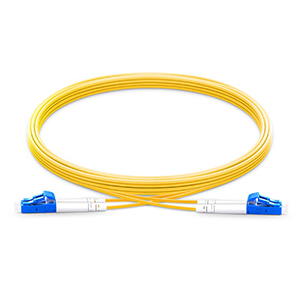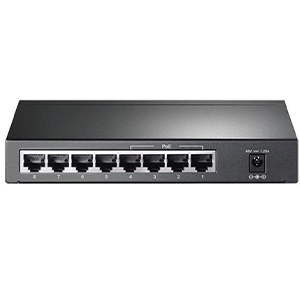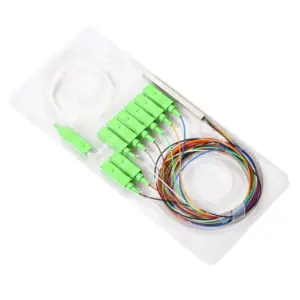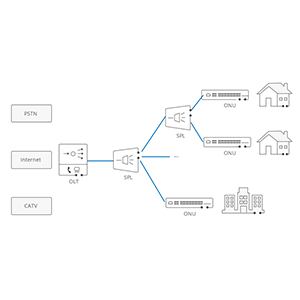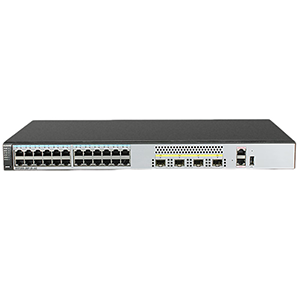Optical fiber is undoubtedly a crucial transmission medium in modern communication networks. This article will focus on the bidirectional full-duplex transmission characteristics of single-mode optical fiber. We will first summarize the transmission modes of optical fiber and explain the differences between single-mode fiber and multi-mode fiber in optical signal transmission. Next, we will conduct an in-depth analysis of the physical mechanism and technical implementation of single-mode fiber to achieve bidirectional signal transmission.
On this basis, we will introduce the key concepts of single-mode fiber full-duplex transmission and explain its specific technical implementation. In addition, we will also discuss the key factors that affect the full-duplex performance of single-mode fiber, including the polarization, wavelength, power, etc. of the optical signal. Finally, we will list the typical applications of single-mode fiber full-duplex in different application scenarios and analyze its advantages in improving network efficiency and flexibility.

Overview of optical fiber transmission modes
Let me introduce to you the basic characteristics of single-mode fiber and multi-mode fiber and their differences in optical signal transmission:
Single-Mode Fiber (SMF):
- Single-mode fiber has a smaller core diameter, usually 8-10 microns, and only supports a single light propagation mode.
- Since optical signals have only one propagation mode in single-mode optical fiber, inter-modal dispersion does not occur.
- Single-mode optical fiber has low transmission loss and can achieve high-bandwidth transmission over longer distances.
- Suitable for long-distance, high-speed optical communication systems, such as metropolitan area networks and long-distance trunk networks.
Multi-Mode Fiber (MMF):
- Multimode fiber has a larger core diameter, usually 50 or 62.5 microns, and can support multiple propagation modes.
- Due to the delay differences between multiple propagation modes, inter-mode dispersion will occur and limit the transmission bandwidth.
- Multimode optical fiber has high transmission loss and is suitable for short-distance, medium- and low-speed application scenarios.
- Commonly used in scenarios such as local area networks, office networks, and internal connections in computer rooms.
The difference in transmission between single-mode fiber and multi-mode fiber:
- Bandwidth: The bandwidth of single-mode fiber is much higher than that of multi-mode fiber, and it can support high-speed Ethernet such as 10GbE and 40GbE.
- Transmission distance: Single-mode optical fiber can transmit tens of kilometers, while multi-mode optical fiber can generally only transmit hundreds of meters.
- Power consumption: Single-mode fiber requires lower light transmission power, while multi-mode fiber requires higher power.
- Cost: Single-mode optical fiber components and equipment costs are generally higher, while multi-mode optical fiber is relatively lower.
In general, there are big differences between single-mode optical fiber and multi-mode optical fiber in terms of optical signal transmission performance and applicable scenarios. Single-mode fiber is more suitable for long-distance, high-bandwidth applications, while multi-mode fiber is suitable for short-distance, medium-to-low-speed scenarios. When choosing a fiber type, there are trade-offs and choices based on specific network requirements.
Principle of bidirectional transmission of single-mode optical fiber
Let me introduce to you in detail how single-mode fiber realizes bidirectional signal transmission:
Bidirectional transmission principle of single-mode optical fiber:
- Single-mode fiber can realize bidirectional signal transmission through different wavelengths. This technology is called wavelength division multiplexing (WDM).
- On single-mode fiber, signals transmitted in one direction use one wavelength (such as 1310nm), while signals transmitted in the other direction use another wavelength (such as 1550nm).
- These two optical signals with different wavelengths can be transmitted bidirectionally on the same optical fiber without interfering with each other.
- Use a Wavelength-Division Multiplexer (WDM) at both ends of the optical fiber to multiplex/demultiplex the optical signals in both directions.
Physical mechanism of bidirectional transmission of single-mode fiber:
- The light transmission mechanism of single-mode fiber is based on the total reflection propagation of light in the fiber core.
- Because light of different wavelengths has different refractive indexes in optical fibers, bidirectional transmission can be achieved in the same optical fiber core.
- The optical signal with a wavelength of 1310nm is mainly reflected and propagated inside the optical fiber, while the optical signal with a wavelength of 1550nm is reflected and propagated in the outer layer.
- This physical mechanism ensures that optical signals in two directions will not interfere with or couple with each other.
Technical realization of bidirectional transmission of single-mode optical fiber:
- Usually CWDM (coarse wavelength division multiplexing) or DWDM (dense wavelength division multiplexing) technology is used.
- CWDM uses 8-18 wavelength channels with larger intervals, while DWDM uses 40-80 wavelength channels with smaller intervals.
- Use WDM multiplexers at both ends of the optical fiber to multiplex or separate optical signals in both directions.
- Use specially designed light transmitters and receivers at the same time to ensure signal transmission at different wavelengths.
- In this way, single-mode fiber can achieve bidirectional, high-bandwidth signal transmission.
In short, single-mode optical fiber achieves bidirectional high-speed signal transmission by adopting WDM technology and cleverly utilizing the transmission characteristics of light of different wavelengths in the optical fiber. This greatly improves the utilization efficiency of optical fibers and lays the foundation for the development of high-speed optical communication networks.
Full-duplex transmission characteristics of single-mode optical fiber
Let me introduce to you the full-duplex transmission characteristics of single-mode fiber:
The concept of full-duplex transmission over single-mode optical fiber:
- Full-Duplex transmission means that both parties can send and receive data at the same time, that is, two-way communication.
- For single-mode optical fiber, full-duplex transmission means that bidirectional high-speed data transmission can be achieved simultaneously on the same optical fiber.
- Compared with half-duplex, this transmission method can greatly improve the transmission efficiency and communication performance of optical fiber.
Technical realization of single-mode fiber full-duplex transmission:
- The key technology to achieve full-duplex transmission over single-mode fiber is wavelength division multiplexing (WDM).
- Bidirectional independent communication can be achieved on the same optical fiber by mapping transmit and receive signals to different wavelengths.
- Specifically, CWDM or DWDM technology is used to use wavelengths such as 1310nm and 1550nm for transmission and reception respectively.
- Use WDM multiplexers at both ends of the optical fiber to multiplex or separate the sending and receiving signals.
Advantages of single-mode fiber full-duplex transmission:
- Improves the transmission efficiency of optical fiber and maximizes the utilization of optical fiber bandwidth resources.
- Reduces the delay of signal transmission and is suitable for application scenarios with strong real-time performance.
- Enhanced the reliability and fault tolerance of the network. Even if one direction fails, the other direction can still work normally.
- Support higher aggregate bandwidth and provide the foundation for the next generation of high-speed optical networks.
In short, the full-duplex transmission characteristics of single-mode optical fiber are realized based on WDM technology. It makes full use of the physical characteristics of single-mode optical fiber and improves the transmission efficiency and network performance of the optical fiber. This is critical to building high-speed, reliable optical network infrastructure.
Factors affecting the full-duplex performance of single-mode fiber
Let me analyze in detail the main factors affecting the full-duplex transmission performance of single-mode fiber:
The impact of optical signal characteristics on full-duplex performance:
- Optical polarization (Polarization): Due to factors such as stress and bending that may exist inside the single-mode fiber, the optical polarization will change, thus affecting the detection at the receiving end.
- Optical wavelength (Wavelength): Optical signals of different wavelengths have different propagation characteristics in optical fibers, such as refractive index, loss, etc., which may affect the isolation of full-duplex.
- Optical Power: If the power at the transmitter is too high, it may cause nonlinear effects and degrade the performance of the receiver.
The impact of fiber optic connection equipment on full-duplex performance:
- Fiber optic connector (Connector): The quality and cleanliness of the connector contact surface will affect the coupling efficiency of the optical signal, thereby affecting the full-duplex performance.
- Optocoupler (Coupler): Optocoupler used to separate/multiplex sending and receiving signals. If the isolation is not enough, it will cause signal crosstalk.
- Optical Circulator: A special device used for bidirectional optical isolation. Its isolation performance directly affects the isolation of full-duplex.
Influence of other factors:
- The optical fiber itself: If the optical fiber has problems such as macrobending or microbending, it will also cause problems such as polarization mode dispersion and affect full-duplex performance.
- Environmental conditions: Environmental changes such as temperature and humidity may also cause changes in fiber characteristics, thereby affecting full-duplex transmission.
- Device aging: As the use time increases, the performance of optical devices may gradually decline, and full-duplex performance will also be affected.
To sum up, the performance of single-mode fiber full-duplex transmission is affected by many factors, including the characteristics of the optical signal itself, the performance of the optical fiber connection equipment, and external environmental conditions. Only by fully considering and optimizing these factors can the best performance of single-mode fiber full-duplex transmission be achieved.
Application of single-mode optical fiber full duplex in practical applications
Let me introduce to you some typical usage scenarios of single-mode fiber full-duplex in practical applications and the advantages it brings:
Typical application scenarios:
- Data center network: Single-mode optical fiber full-duplex is widely used in the core switching and server interconnection of data centers to improve transmission efficiency.
- Metro/long-distance optical network: Full-duplex single-mode optical fiber is used for backbone transmission of metropolitan area networks and trunk networks to support high-bandwidth services.
- 5G/6G mobile network: Full-duplex single-mode optical fiber is used in the backhaul network between 5G/6G base stations to meet massive data needs.
- Enterprise campus network: Full-duplex single-mode optical fiber is used in building/campus network interconnection in enterprise campuses to enhance network performance.
- Industrial automation network: Full-duplex single-mode optical fiber is used for industrial Ethernet applications in factories, petrochemical and other industries.
Advantages of full-duplex single-mode fiber:
- Improved transmission efficiency: Due to the realization of two-way independent transmission, the bandwidth resources of optical fiber are fully utilized.
- Enhanced network flexibility: Full-duplex transmission reduces the restrictions on network deployment and improves the flexibility of network configuration.
- Delay and jitter reduction: Full-duplex can reduce the queuing delay of signals and is suitable for applications with high real-time requirements.
- Improved reliability and redundancy: even if one direction fails, the other direction can still work normally.
- Support high-bandwidth aggregation: Full-duplex helps build higher-speed, larger-bandwidth aggregation and backbone networks.
In general, single-mode optical fiber full-duplex transmission technology is widely used in various high-speed networks, which not only improves the transmission efficiency of the network, but also enhances the flexibility and reliability of the network. With the development of emerging services such as 5G and industrial Internet, single-mode fiber full-duplex will play an increasingly important role in future network construction.
Summary
The bidirectional full-duplex transmission characteristics of single-mode optical fiber is undoubtedly an important innovation in modern optical communication technology. Our company has long been focused on the R&D and production of single-mode optical fibers and related products, and has rich industry experience. Our single-mode optical fiber products have reached industry-leading levels in terms of transmission performance and anti-interference capabilities, and can fully meet your demanding needs for high-speed, two-way and full-duplex communications.
Whether you are applying it to a high-bandwidth backbone network or deploying it in a flexible access network, we can provide you with customized single-mode optical fiber solutions. At the same time, our professional team is ready to provide you with technical guidance and after-sales service to ensure that your network system can operate stably in the long term. Contact us now to learn more about our company’s single-mode optical fiber product line and related services!
Single Mode Fiber FAQ
Single-mode fiber is a type of optical fiber that has a very small core diameter, typically 8-10 microns, which allows only a single mode of light to propagate.
Yes, single-mode fiber is inherently bidirectional, meaning it can transmit signals in both directions simultaneously.
Full-duplex operation refers to the ability to transmit and receive data simultaneously in both directions over a communication link.
Yes, single-mode fiber is capable of full-duplex operation, allowing for simultaneous two-way communication.
The key advantages include increased bandwidth utilization, reduced latency, and more efficient use of the fiber infrastructure.
Common technologies include wavelength-division multiplexing (WDM) and bi-directional optical module (BiDi) transceivers.
Bidirectional full-duplex single-mode fiber is commonly used in telecommunications, data centers, and other high-speed networking applications.
Considerations may include ensuring proper wavelength planning, maintaining signal isolation, and managing power levels to avoid interference.
Compared to unidirectional or half-duplex fiber links, bidirectional full-duplex single-mode fiber offers more efficient use of the fiber infrastructure.
Ongoing advancements include the development of higher-speed and more cost-effective bidirectional fiber optic components and systems.

